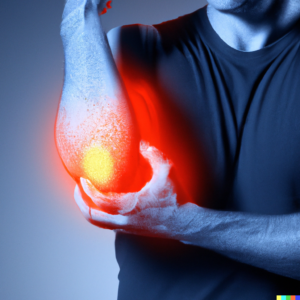What is tennis elbow?

Similar, but not to be confused with golfer’s elbow (medial epicondylitis, technically speaking), tennis elbow (lateral epicondylitis), is a condition characterized by pain on the outer part of the elbow. The pain is caused by inflammation of the tendons that attach to the lateral epicondyle, a bony prominence on the outer part of the elbow.
Not exclusive to tennis players or golfers, elbow epicondylitis is typically caused by repetitive motions of the wrist and arm or athletic trauma, such as those used in racquet sports and rock climbing, but it can also be caused by other simple everyday activities that involve repetitive arm and wrist movements, like typing, painting, guitar playing…and the list goes on.
Symptoms of tennis elbow include pain and tenderness on the outer part of the elbow, weakness in the forearm, and pain or tenderness when gripping or lifting objects. Many tennis elbow sufferers wait until they’re experiencing chronic tennis elbow or a high degree of elbow pain before seeking treatment, like standard physical therapy.
Standard treatment
The standard treatment for tennis elbow typically includes a combination of non-surgical and self-care measures. These may include:
- Rest and activity modification: Avoiding activities that cause pain and allowing time for the elbow to heal. This is the typical starting point for any tendonitis.
- Physical therapy: A physical therapist can teach you tennis elbow exercises that work through multiple ranges of motion to help stretch and strengthen the muscles and tendons in your elbow and forearm. Physical therapists will often prescribe very effective eccentric exercises, but time and/or expense often prevent us from going.
- Over-the-counter pain medications: such as ibuprofen and naproxen can help reduce inflammation and pain. Sometimes we need quick pain relief, but these are not considered long-term solutions, and can actually weaken the tissues over time.
- Ice therapy: Applying ice to the elbow can help reduce pain and inflammation.
- Bracing: A brace or support strap worn around the elbow can help take pressure off the tendons and provide support.
- Injections: Injection treatments such as corticosteroids can be helpful in case of severe inflammation.
- Surgery: Elbow surgery is considered as a last resort for people with severe cases of tennis elbow that do not respond to other treatments.
It is important to consult with your healthcare provider to determine the best treatment plan for you, and don’t try anything crazy without medical supervision. Use your brain! They can also rule out other conditions that may be causing your elbow pain and recommend additional or alternative treatments if needed.
Our recommendations for your tennis elbow pain
Voodoo Flossing
Unfortunately, we’ve not found a miracle cure, but in our experience, floss bands can provide miracle relief, at least long enough to power through your exercise session.
Voodoo flossing, also known as compression flossing, is a technique that involves wrapping a band of compression material, such as athletic tape or a Voodoo band, around a joint or muscle in order to compress and restrict movement in that area. The technique is designed to improve mobility, reduce pain, and increase blood flow to the area.
It’s not recommended to use Voodoo flossing as a sole treatment. It’s better to use it in conjunction with other treatments such as rest, activity modification, stretching and strengthening exercises, ice therapy and medication if necessary.
Kelly Starrett, the creator of the Voodoo floss band, has a helpful video on elbow flossing:
Tyler twist
The Tyler Twist is a twisting exercise (oscillation movement) to help strengthen the muscles and tendons in the forearm that are affected by tennis elbow. The exercise is typically performed with the use of a rubber resistance band or tubing. The Thera-Band FlexBar is perfect for this novel exercise, as well as other hand rehabilitation protocols and generally increasing grip and forearm strength. Many users also report good results for medial epicondylitis.
To perform the Tyler Twist:
- Place a rubber band or tubing around your foot and hold onto the band or tubing with your hand.
- Stand up straight, and keep your elbow close to your body and your forearm parallel to the ground.
- Slowly twist your wrist away from your body, using your forearm muscles to resist the resistance of the band or tubing.
- Hold the position for a moment, then slowly return to the starting position.
- Repeat the exercise for the recommended number of repetitions.
The Thera-Band FlexBar comes in a variety of progressive resistance levels, which require different pounds of force to manipulate. It’s a deceptively simple piece of dry natural rubber, proven to relieve tendonitis pain. Clinically researched and proven to reduce elbow pain by 81% and increase strength in the tendons by 72% in tennis elbow patients.
Yellow flexbar (extra light, 1 3/8″ diameter)
Red flexbar (light, 1 1/2″ inch diameter)
Green flexbar (medium, 1 3/4″ diameter)
Buy the whole set:
Here’s a helpful video on the FlexBar exercise:
